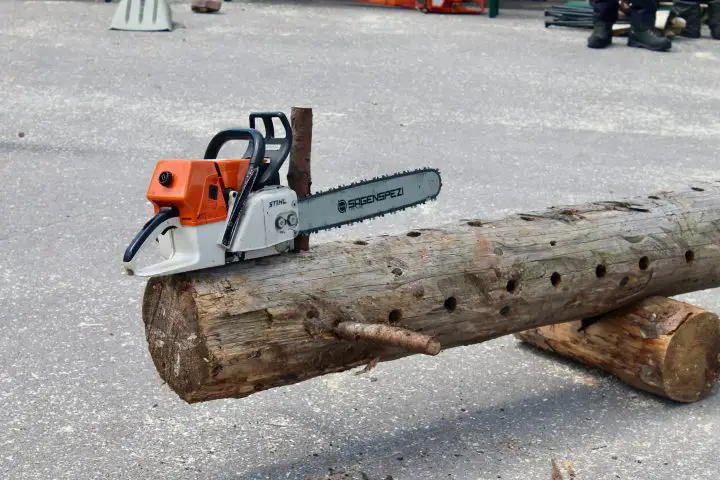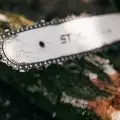The chainsaw bar, guide bar also referred to as a chainsaw blade is a replaceable component which exists in multiple formats or types.
Each of those chainsaw bar types is best suited to an application and / or usage pattern.
By definition, it’s therefore possible to choose a sub-optimal or even dangerous chainsaw guide bar for your given application – as we know, the chainsaw guide bar can be the cause of excessive kickback for a number of reasons.
Table of Contents
- Chainsaw Bar Types
- Laminated Chainsaw Bars vs Solid Chainsaw Bars – Which to choose?
- Chainsaw Guide Bar Features
- What are Chainsaw Bar Rails?
- What is the Chainsaw Bar Groove?
- What is the Chainsaw Bar Tip or Nose?
- What is a Chainsaw Bar Nose Sprocket?
- What is the Chainsaw Bar Oiling hole?
- What is the Chainsaw Bar Tension Adjuster Hole?
- What is the Chainsaw Bar Mounting Slot?
- What is the Chainsaw Bar Mounting Tail?
- Chainsaw Guide Bar Lengths
- Chainsaw Guide Bar Size & Type Identification
- Chainsaw Guide Bar Alternative Names
- Chainsaw Bar Frequently Asked Questions
Chainsaw Bar Types
Some chainsaw bar types are unique to each chainsaw brand or manufacturer.
The chainsaw bar material, coating, shape, format and many other characteristics can indeed vary significantly between chainsaw manufacturer.
It can therefore appear that there are an infinite number of guide bar types – but they can be broken down into some ‘common sense’ high level categories to cut through the manufacturer specific jargon.

List of common types of chainsaw guide bars:
- Solid Bars (hard nosed bars)
- Solid Bars with replaceable bar tips (including nose sprocket)
- Laminated Bars (hard nosed bars)
- Laminated Bars with replaceable bar tips (including nose sprocket)
- Specialist Material & Configuration Bars (such as X-Force bars from Husqvarna)
What are Solid Hard Nosed Guide Bars?
A solid hard nosed chainsaw bar is made of a single piece of metal into which a guide rail or groove is machined on it’s outer edge. It has no moving parts, replaceable tip or sprockets. The term ‘hard nosed’ is used to distinguish these guide bars from other types of chainsaw bar which have replaceable tips at the ‘nose’ or end of the guide bar.
More about parts of a chainsaw on the blog.
What are Solid Guide Bars with Replaceable Tips?
Solid guide bars with replaceable tips are made of a single piece of metal into which a guide rail or groove is machined on it’s outer edge. The tip or end of the guide bar is replaceable and houses a sprocket which rotates and guides the chainsaw chain around the nose of the bar.
What are Laminated Hard Nosed Guide Bars?
Laminated Hard Nosed Guide Bars are made of multiple pieces of metal welded together, having a ‘laminated structure’. It has no moving parts, replaceable tip or sprockets. The term ‘hard nosed’ is used to distinguish these guide bars from other types of chainsaw bar which have replaceable tips at the ‘nose’ or end of the guide bar.
This type of guide bar isn’t particularly common, as the majority of laminated guide bars have replaceable tips. Hard nosed laminated guide bars tend to be those with a small nose radius more typically used for chainsaw carving.
What are Laminated Guide Bars with Replaceable Tips?
Laminated Hard Nosed Guide Bars are made of multiple pieces of metal welded together, having a ‘laminated structure’. The tip or end of the guide bar is replaceable and houses a sprocket which rotates and guides the chainsaw chain around the nose of the bar.
What are Specialist Material & Configuration Chainsaw Bars?
Specialist guide bars offered by chainsaw manufacturers are designed to suit niche or specific uses, more often designed for commercial or industrial applications.
Specialist materials, coatings, lengths and shapes are offered by many manufacturers to offer enhanced durability, accuracy, consistency, efficiency and more.
Laminated Chainsaw Bars vs Solid Chainsaw Bars – Which to choose?
Laminated chainsaw bars are more flexible, lighter weight and in some cases less expensive than the solid chainsaw bar alternatives. In applications where you need flexibility and a lower overall chainsaw weight, a laminated chainsaw bar is therefore an obvious choice.
Solid chainsaw bars set the standard when it comes to sheer strength and rigidity. So if flexing of the chainsaw bar is a concern, which may be the case on your chainsaw mill for example (see discussion here) – then choosing a solid chainsaw bar makes sense.
Chainsaw Guide Bar Features
All chainsaw bar types share the majority of features, regardless of whether they’re laminated, solid or specialist guide bars.
Those guide bar features are:
- Bar Rails
- Bar Groove
- Tip or Nose
- Nose Sprocket
- Oiling hole
- Tension Adjuster hole
- Mounting slot
- Mounting tail
What are Chainsaw Bar Rails?
Chainsaw bar rails protrude from either side of the guide bar groove, surrounding and enclosing the groove in which the chainsaw chain runs.
What is the Chainsaw Bar Groove?
The chainsaw bar groove is the channel in which the chainsaw chain sits as it runs along the chainsaw bar.
What is the Chainsaw Bar Tip or Nose?
The chainsaw bar tip is the rounded end of the chainsaw bar where the chainsaw chain turns 180 degrees and returns along it’s closed loop path. Chainsaw bar tips or noses can be both ‘hard’ and integrated into the bar, or replaceable, containing a sprocket on which the chain rotates.
What is a Chainsaw Bar Nose Sprocket?
A chainsaw nose sprocket is a sprocket on which the chainsaw chain rotates, located at the tip or nose of the chainsaw guide bar. The chainsaw nose sprocket reduces friction as the chain rotates on a bearing at the tip of the chainsaw, instead of rotating in the groove of the chainsaw blade where the surface of the chain interacts with the surfaces within the groove.
What is the Chainsaw Bar Oiling hole?
The chainsaw guide bar oiling hole is the orifice through which the chain oiler feeds the guide bar lubricating oil from an oil reservoir.
What is the Chainsaw Bar Tension Adjuster Hole?
The tension adjuster hole in the chainsaw bar is the locator of the pawl used to adjust chainsaw chain tension.
What is the Chainsaw Bar Mounting Slot?
The chainsaw bar mounting slot is a shaped slot that meshes with a corresponding feature inside the main chainsaw housing. Chainsaw Bar Mounting Slot shapes and configurations are unique to chainsaw manufacturers.
What is the Chainsaw Bar Mounting Tail?
The chainsaw bar mounting tail is the portion of the chainsaw guide bar that slots inside the main housing of the chainsaw when the chainsaw bar is attached to the chainsaw.
Chainsaw Guide Bar Lengths
There are a multitude of chainsaw guide bar lengths available to suit the application and power of your chainsaw.
Choosing the right guide bar length is critical to the performance of the cut and the longevity of your chainsaw – check out my guide on measuring and selecting the right length guide bar for your chainsaw.
Chainsaw Guide Bar Size & Type Identification
A visual review of the guide bar should reveal whether it’s ‘hard nosed’ or has a replaceable tip with a sprocket – or is some other configuration.
The chainsaw guide bar will also have numbers etched or printed onto it to inform you of the size of the bar groove.
This information is vital when matching the chainsaw bar to the chainsaw chain. Pay attention to these numbers, and read my guide explaining exactly what the numbers on a chainsaw bar actually mean.
Chainsaw Guide Bar Alternative Names
You may hear chainsaw guide bars referred to as a number of common alternative names, such as:
- Chainsaw Bars
- Chainsaw Guide Bars
- Guide Bars
- Chainsaw Blades
- Chainsaw Guide Blades
- Guide Blades
Rest assured, these are all the same chainsaw component.
Chainsaw Bar Frequently Asked Questions
What is a chainsaw bar?
A chainsaw bar or ‘blade’ is the component around which the chainsaw chain is located, with it’s purpose being to guide the chainsaw chain as it moves. The chainsaw bar often referred to as a guide bar or blade contains a groove into which the chainsaw chain fits and moves through. The chainsaw guide bar and chain are oiled to minimise friction between the chainsaw chain as it travels through the groove on the guide bar. Chainsaw guide bars come in many different shapes, sizes and guide bar lengths.
What are solid chainsaw bars?
A solid chainsaw guide bar is made of a single piece of metal into which a guide rail or groove is machined on it’s outer edge.
What are laminated chainsaw bars?
Laminated chainsaw guide bars are made of multiple pieces of metal welded together, having a ‘laminated structure’.
What are hard nosed chainsaw bars?
Hard nosed chainsaw guide bars guide the chainsaw chain using a groove that extends around the entire outer edge of the chainsaw be. They have no moving parts, replaceable tip or sprockets. The term ‘hard nosed’ is used to distinguish these guide bars from other types of chainsaw bar which have replaceable tips at the ‘nose’ or end of the guide bar.
What are replaceable tip chainsaw bars?
Replaceable tip chainsaw bars have a replaceable tip at the end of the guide bar which houses a sprocket that rotates and guides the chainsaw chain around the nose of the bar.
What is the difference between solid and laminated chainsaw bars?
Solid and laminated chainsaw bars differ in their construction, with solid chainsaw bars made from a single sheet of metal, meanwhile laminated chainsaw bars are constructed of layered or ‘laminated’ sheets of metal. Laminated chainsaw bars offer flexibility, while solid chainsaw bars provide ultimate sheer strength.




